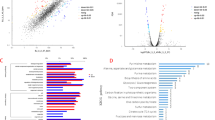Abstract
Objectives
To reduce the unpleasant odor during 1-deoxynojirimycin (DNJ) production, the genes of leucine dehydrogenase (bcd) and phosphate butryltransferase (ptb) were deleted from Bacillus amyloliquefaciens HZ-12, and the concentrations of branched-chain short fatty acids (BCFAs) and DNJ were compared.
Results
By knockout of the ptb gene, 1.01 g BCFAs kg−1 was produced from fermented soybean by HZ-12Δptb. This was a 56% decrease compared with that of HZ-12 (2.27 g BCFAs kg−1). Moreover, no significant difference was found in the DNJ concentration (0.7 g kg−1). After further deletion of the bcd gene from HZ-12Δptb, no BCFAs was detected in fermented soybeans with HZ-12ΔptbΔbcd, while the DNJ yield decreased by 26% compared with HZ-12.
Conclusions
HZ-12Δptb had decreased BCFAs formation but also maintained the stable DNJ yield, which contributed to producing DNJ-rich products with decreased unpleasant smell.



Similar content being viewed by others
References
Cai D, Liu M, Wei X, Li X, Wang Q, Nomura CT, Chen S (2016) Use of Bacillus amyloliquefaciens HZ-12 for high-level production of the blood glucose lowering compound, 1-deoxynojirimycin (DNJ), and nutraceutical enriched soybeans via fermentation. Appl Biochem. doi:10.1007/s12010-016-2272-8
Cho Y, Park Y, Lee J, Kang K, Hwang K, Seong S (2008) Hypoglycemic effect of culture broth of Bacillus subtilis S10 producing 1-deoxynojirimycin. J Korean Soc Food Sci Nutr 37:1401–1407
Kang K et al (2011) Identification of the genes involved in 1-deoxynojirimycin synthesis in Bacillus subtilis MORI 3 K-85. J Microbiol 49:431–440
Liu Q, Li X, Li C, Zheng Y, Wang F, Li H, Peng G (2016) 1-Deoxynojirimycin alleviates liver injury and improves hepatic glucose metabolism in db/db mice. Molecules 21:279
Onose S, Ikeda R, Nakagawa K, Kimura T, Yamagishi K, Higuchi O, Miyazawa T (2013) Production of the α-glycosidase inhibitor 1-deoxynojirimycin from Bacillus species. Food Chem 138:516–523
Paek N, Kang D, Choi Y, Lee J, Kim T, Kim K (1997) Production of 1-deoxynojirimycin by Streptomyces sp. SID9135. J Microbiol Biotechnol 7:262–266
Qi G et al (2014) Deletion of meso-2,3-butanediol dehydrogenase gene budC for enhanced D-2,3-butanediol production in Bacillus licheniformis. Biotechnol Biofuel 7:16
Qiu Y, Xiao F, Wei X, Wen Z, Chen S (2014) Improvement of lichenysin production in Bacillus licheniformis by replacement of native promoter of lichenysin biosynthesis operon and medium optimization. Appl Microbiol Biotechnol 98:8895–8903
Seo MJ, Nam YD, Lee SY, Park SL, Yi SH, Lim SI (2013) Isolation of the putative biosynthetic gene cluster of 1-deoxynojirimycin by Bacillus amyloliquefaciens 140 N, its production and application to the fermentation of soybean paste. Biosci Biotechnol Biochem 77:398–401
Sirobhushanam S, Galva C, Sen S, Wilkinson BJ, Gatto C (2016) Broad substrate specificity of phosphotransbutyrylase from Listeria monocytogenes: a potential participant in an alternative pathway for provision of acyl CoA precursors for fatty acid biosynthesis. Biochim Biophys Acta 1861:1102–1110
Smit BA, Engels WJ, Smit G (2009) Branched chain aldehydes: production and breakdown pathways and relevance for flavour in foods. Appl Microbiol Biotechnol 81:987–999
Takemura H, Ando N, Tsukamoto Y (2000) Breeding of branched short-chain fatty acids non-producing natto bacteria and its application to production of natto with light smells. J Jpn Soc Food Sci 47:773–779
Yatsunami K, Ichida M, Onodera S (2008) The relationship between 1-deoxynojirimycin content and alpha-glucosidase inhibitory activity in leaves of 276 mulberry cultivars (Morus spp.) in Kyoto Japan. J Nat Med 62:63–66
Yu M, Zhang Y, Tang IC, Yang ST (2011) Metabolic engineering of Clostridium tyrobutyricum for n-butanol production. Metab Eng 13:373–382
Zhou L, Fang L, Sun Y, Su Y, Zhu W (2016) Effects of the dietary protein level on the microbial composition and metabolomic profile in the hindgut of the pig. Anaerobe 38:61–69
Acknowledgments
This work was funded by the National Natural Science Foundation of China (31501468) and the Fundamental Research Funds for the Central Universities (2662016PY121).
Author information
Authors and Affiliations
Corresponding author
Ethics declarations
Supporting information
Supplementary Table 1—Strains and plasmids used.
Supplementary Table 2—Primers used for PCR.
Electronic supplementary material
Below is the link to the electronic supplementary material.
Rights and permissions
About this article
Cite this article
Chen, Y., Liu, M., Chen, S. et al. Decreased formation of branched-chain short fatty acids in Bacillus amyloliquefaciens by metabolic engineering. Biotechnol Lett 39, 529–533 (2017). https://doi.org/10.1007/s10529-016-2270-5
Received:
Accepted:
Published:
Issue Date:
DOI: https://doi.org/10.1007/s10529-016-2270-5




